La Tour-de-Peilz
La Tour-de-Peilz (French pronunciation: [latuʁdəpɛ][3]) is a municipality in Riviera-Pays-d'Enhaut District in the canton of Vaud in Switzerland. The city is located on Lake Geneva between Montreux and Vevey (their agglomeration counting some 80,000 inhabitants).[4]
La Tour-de-Peilz | |
|---|---|
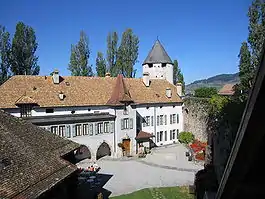 Musée Suisse du Jeu | |
 Coat of arms | |
Location of La Tour-de-Peilz 
| |
 La Tour-de-Peilz  La Tour-de-Peilz | |
| Coordinates: 46°27′N 06°52′E | |
| Country | Switzerland |
| Canton | Vaud |
| District | Riviera-Pays-d'Enhaut |
| Government | |
| • Mayor | Syndic (list) |
| Area | |
| • Total | 3.29 km2 (1.27 sq mi) |
| Elevation | 382 m (1,253 ft) |
| Population (2018-12-31)[2] | |
| • Total | 11,829 |
| • Density | 3,600/km2 (9,300/sq mi) |
| Demonym(s) | Les Boélands Lè Verra |
| Time zone | UTC+01:00 (Central European Time) |
| • Summer (DST) | UTC+02:00 (Central European Summer Time) |
| Postal code(s) | 1814 |
| SFOS number | 5889 |
| Localities | Burier |
| Surrounded by | Saint-Légier-La Chiésaz, Blonay, Montreux, Vevey |
| Twin towns | Ornans (France), Thalwil (Switzerland) |
| Website | www Profile (in French), SFSO statistics |
History
In the area Celt, Roman and Burgundian remains have been excavated. In the Middle Ages it was under the bishops of Sion and the counts of Geneva, until it was acquired by Savoy.
On 8 June 1476, after a heroic resistance, its inhabitants were massacred by mountain warriors from Haut-Simmental, led by the Bernese Niklaus Zurkinden. Later the canton of Bern conquered the village along with the rest of the region. It remained part of Bern until the foundation of the canton of Vaud in 1803.
Geography
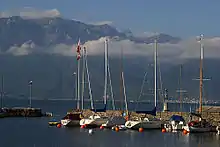
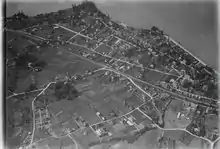
La Tour-de-Peilz has an area, as of 2009, of 3.2 square kilometers (1.2 sq mi). Of this area, 0.95 km2 (0.37 sq mi) or 29.3% is used for agricultural purposes, while 0.15 km2 (0.058 sq mi) or 4.6% is forested. Of the rest of the land, 2.15 km2 (0.83 sq mi) or 66.4% is settled (buildings or roads), 0.01 km2 (2.5 acres) or 0.3% is either rivers or lakes.[5]
Of the built up area, housing and buildings made up 46.3% and transportation infrastructure made up 13.9%. while parks, green belts and sports fields made up 4.6%. Out of the forested land, 1.2% of the total land area is heavily forested and 3.4% is covered with orchards or small clusters of trees. Of the agricultural land, 2.5% is used for growing crops and 11.4% is pastures, while 15.4% is used for orchards or vine crops. All the water in the municipality is in lakes.[5]
The municipality was part of the Vevey District until it was dissolved on 31 August 2006, and La Tour-de-Peilz became part of the new district of Riviera-Pays-d'Enhaut.[6]
Coat of arms
The blazon of the municipal coat of arms is Per pale Argent and Gules, a Castle counterchanged.[7]
Demographics
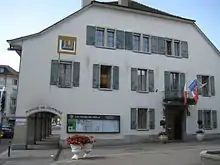
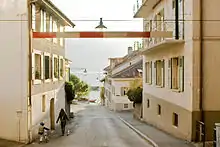
La Tour-de-Peilz has a population (as of December 2019) of 11,884.[8] As of 2008, 25.6% of the population are resident foreign nationals.[9] Over the last 10 years (1999–2009 ) the population has changed at a rate of 7.3%. It has changed at a rate of 7.8% due to migration and at a rate of -0.2% due to births and deaths.[10]
Most of the population (as of 2000) speaks French (8,490 or 83.0%) as their first language, with German being second most common (605 or 5.9%) and Italian being third (295 or 2.9%). There are 5 people who speak Romansh.[11]
The age distribution, as of 2009, in La Tour-de-Peilz is; 1,092 children or 10.1% of the population are between 0 and 9 years old and 1,233 teenagers or 11.5% are between 10 and 19. Of the adult population, 1,152 people or 10.7% of the population are between 20 and 29 years old. 1,325 people or 12.3% are between 30 and 39, 1,702 people or 15.8% are between 40 and 49, and 1,313 people or 12.2% are between 50 and 59. The senior population distribution is 1,304 people or 12.1% of the population are between 60 and 69 years old, 969 people or 9.0% are between 70 and 79, there are 571 people or 5.3% who are between 80 and 89, and there are 104 people or 1.0% who are 90 and older.[12]
As of 2000, there were 3,882 people who were single and never married in the municipality. There were 4,881 married individuals, 726 widows or widowers and 741 individuals who are divorced.[11]
As of 2000, there were 4,870 private households in the municipality, and an average of 2.1 persons per household.[10] There were 2,012 households that consist of only one person and 192 households with five or more people. Out of a total of 4,951 households that answered this question, 40.6% were households made up of just one person and there were 28 adults who lived with their parents. Of the rest of the households, there are 1,284 married couples without children, 1,164 married couples with children There were 296 single parents with a child or children. There were 86 households that were made up of unrelated people and 81 households that were made up of some sort of institution or another collective housing.[11]
In 2000 there were 528 single family homes (or 44.5% of the total) out of a total of 1,186 inhabited buildings. There were 456 multi-family buildings (38.4%), along with 159 multi-purpose buildings that were mostly used for housing (13.4%) and 43 other use buildings (commercial or industrial) that also had some housing (3.6%).[13]
In 2000, a total of 4,780 apartments (88.2% of the total) were permanently occupied, while 456 apartments (8.4%) were seasonally occupied and 186 apartments (3.4%) were empty.[13] As of 2009, the construction rate of new housing units was 2.1 new units per 1000 residents.[10] The vacancy rate for the municipality, in 2010, was 0.35%.[10]
The historical population is given in the following chart:[14]

Heritage sites
.jpg.webp)
The Villa Kenwin is listed as a Swiss heritage site of national significance.[15]
The Swiss Museum of Games is housed in the castle of La Tour-de-Peilz. Founded in 1987, it offers a family friendly display of games from across the world.[16]
Politics
In the 2007 federal election the most popular party was the SP which received 24.28% of the vote. The next three most popular parties were the SVP (18.15%), the FDP (14.12%) and the Green Party (14.08%). In the federal election, a total of 2,851 votes were cast, and the voter turnout was 44.9%.[18]
Economy
As of 2010, La Tour-de-Peilz had an unemployment rate of 4.5%. As of 2008, there were 64 people employed in the primary economic sector and about 13 businesses involved in this sector. 299 people were employed in the secondary sector and there were 70 businesses in this sector. 2,236 people were employed in the tertiary sector, with 259 businesses in this sector.[10] There were 4,762 residents of the municipality who were employed in some capacity, of which females made up 46.3% of the workforce.
In 2008 the total number of full-time equivalent jobs was 2,141. The number of jobs in the primary sector was 40, of which 37 were in agriculture and 3 were in fishing or fisheries. The number of jobs in the secondary sector was 280 of which 67 or (23.9%) were in manufacturing and 184 (65.7%) were in construction. The number of jobs in the tertiary sector was 1,821. In the tertiary sector; 323 or 17.7% were in wholesale or retail sales or the repair of motor vehicles, 22 or 1.2% were in the movement and storage of goods, 125 or 6.9% were in a hotel or restaurant, 27 or 1.5% were in the information industry, 22 or 1.2% were the insurance or financial industry, 565 or 31.0% were technical professionals or scientists, 310 or 17.0% were in education and 252 or 13.8% were in health care.[19]
In 2000, there were 1,181 workers who commuted into the municipality and 3,726 workers who commuted away. The municipality is a net exporter of workers, with about 3.2 workers leaving the municipality for every one entering.[20] Of the working population, 21.9% used public transportation to get to work, and 57.5% used a private car.[10]
Religion
From the 2000 census, 3,859 or 37.7% were Roman Catholic, while 3,788 or 37.0% belonged to the Swiss Reformed Church. Of the rest of the population, there were 207 members of an Orthodox church (or about 2.02% of the population), there were 8 individuals (or about 0.08% of the population) who belonged to the Christian Catholic Church, and there were 545 individuals (or about 5.33% of the population) who belonged to another Christian church. There were 17 individuals (or about 0.17% of the population) who were Jewish, and 203 (or about 1.98% of the population) who were Islamic. There were 43 individuals who were Buddhist, 12 individuals who were Hindu and 11 individuals who belonged to another church. 1,303 (or about 12.74% of the population) belonged to no church, are agnostic or atheist, and 482 individuals (or about 4.71% of the population) did not answer the question.[11]
Education
.png.webp)
In La Tour-de-Peilz about 3,931 or (38.4%) of the population have completed non-mandatory upper secondary education, and 1,857 or (18.2%) have completed additional higher education (either university or a Fachhochschule). Of the 1,857 who completed tertiary schooling, 46.3% were Swiss men, 28.0% were Swiss women, 14.6% were non-Swiss men and 11.1% were non-Swiss women.[11]
In the 2009/2010 school year there were a total of 1,221 students in the La Tour-de-Peilz school district. In the Vaud cantonal school system, two years of non-obligatory pre-school are provided by the political districts.[21] During the school year, the political district provided pre-school care for a total of 817 children of which 456 children (55.8%) received subsidized pre-school care. The canton's primary school program requires students to attend for four years. There were 657 students in the municipal primary school program. The obligatory lower secondary school program lasts for six years and there were 543 students in those schools. There were also 21 students who were home schooled or attended another non-traditional school.[22]
As of 2000, there were 1,136 students in La Tour-de-Peilz who came from another municipality, while 406 residents attended schools outside the municipality.[20]
AGSB University is located in the city.
La Tour-de-Peilz is home to 1 museum, the Musée suisse du jeu (Swiss Museum of Games). In 2009 it was visited by 19,244 visitors (the average in previous years was 21,083).[23]
La Tour-de-Peilz is home to the Bibliothèque communale library. The library has (as of 2008) 19,223 books or other media, and loaned out 46,152 items in the same year. It was open a total of 227 days with average of 20 hours per week during that year.[24]
Transportation
The municipality has two railway stations, Burier and La Tour-de-Peilz. Both are on the Simplon line and have regular service to Grandson, Lausanne, and Aigle.
Notable people
- Jean Etienne Waddens was born here in 1738. He was one of the original 4 partners of the North West Company, fur traders who played a major part of the early history of Canada.[25]
- The painter Gustave Courbet lived there from 1874 until his death in December 1877.
- Prince Adalbert of Prussia died there in 1948.
- Princess Adelheid of Saxe-Meiningen died there in 1971.
- Archduchess Isabella of Austria died there in 1973.
- The cellist Dimitry Markevitch was born there in 1923.
- The novelist A.J. Cronin is buried there.
- Businessman Jean-Claude Biver, CEO of numerous watchmakers.
- Tennis player Manuela Maleeva-Fragniere resides with her husband and three children.
- The music producer Robert John "Mutt" Lange
- The singer Shania Twain
- Thomas Zoells, founder of PianoForte Foundation, Chicago, Illinois.
References
- "Arealstatistik Standard - Gemeinden nach 4 Hauptbereichen". Federal Statistical Office. Retrieved 13 January 2019.
- "Ständige Wohnbevölkerung nach Staatsangehörigkeitskategorie Geschlecht und Gemeinde; Provisorische Jahresergebnisse; 2018". Federal Statistical Office. 9 April 2019. Retrieved 11 April 2019.
- Rives du lac - La Tour-de-Peilz.
- "Städtische Bevölkerung: Agglomerationen und isolierte Städte" (in German and French). Neuchâtel, Switzerland: Swiss Federal Statistical Office. 26 August 2016. Retrieved 14 December 2016.
- Swiss Federal Statistical Office-Land Use Statistics 2009 data (in German) accessed 25 March 2010
- Nomenklaturen – Amtliches Gemeindeverzeichnis der Schweiz Archived 2015-11-13 at the Wayback Machine (in German) accessed 4 April 2011
- Flags of the World.com accessed 17-August-2011
- "Ständige und nichtständige Wohnbevölkerung nach institutionellen Gliederungen, Geburtsort und Staatsangehörigkeit". bfs.admin.ch (in German). Swiss Federal Statistical Office - STAT-TAB. 31 December 2019. Retrieved 6 October 2020.
- Swiss Federal Statistical Office - Superweb database - Gemeinde Statistics 1981-2008 Archived 2010-06-28 at the Wayback Machine (in German) accessed 19 June 2010
- Swiss Federal Statistical Office Archived 2016-01-05 at the Wayback Machine accessed 17-August-2011
- STAT-TAB Datenwürfel für Thema 40.3 - 2000 Archived 2013-08-09 at the Wayback Machine (in German) accessed 2 February 2011
- Canton of Vaud Statistical Office (in French) accessed 29 April 2011
- Swiss Federal Statistical Office STAT-TAB - Datenwürfel für Thema 09.2 - Gebäude und Wohnungen Archived 2014-09-07 at the Wayback Machine (in German) accessed 28 January 2011
- Swiss Federal Statistical Office STAT-TAB Bevölkerungsentwicklung nach Region, 1850-2000 Archived 2014-09-30 at the Wayback Machine (in German) accessed 29 January 2011
- "Kantonsliste A-Objekte". KGS Inventar (in German). Federal Office of Civil Protection. 2009. Archived from the original on 28 June 2010. Retrieved 25 April 2011.
- Bekker, Henk. "Visit the Swiss Museum of Games on Lake Geneva". Visit lakeGeneva. Impressum. Retrieved 28 March 2016.
- Conseil des Communes et Regions d'Europe (in French) accessed 27 April 2011
- Swiss Federal Statistical Office, Nationalratswahlen 2007: Stärke der Parteien und Wahlbeteiligung, nach Gemeinden/Bezirk/Canton Archived 2015-05-14 at the Wayback Machine (in German) accessed 28 May 2010
- Swiss Federal Statistical Office STAT-TAB Betriebszählung: Arbeitsstätten nach Gemeinde und NOGA 2008 (Abschnitte), Sektoren 1-3 Archived 2014-12-25 at the Wayback Machine (in German) accessed 28 January 2011
- Swiss Federal Statistical Office - Statweb Archived 2012-08-04 at Archive.today (in German) accessed 24 June 2010
- Organigramme de l'école vaudoise, année scolaire 2009-2010 (in French) accessed 2 May 2011
- Canton of Vaud Statistical Office - Scol. obligatoire/filières de transition (in French) accessed 2 May 2011
- Canton of Vaud Statistical Office - Fréquentation de quelques musées et fondations, Vaud, 2001-2009 (in French) accessed 2 May 2011
- Swiss Federal Statistical Office, list of libraries Archived 2015-07-06 at the Wayback Machine (in German) accessed 14 May 2010
- Dictionary of Canadian Biography accessed 12 December 2018